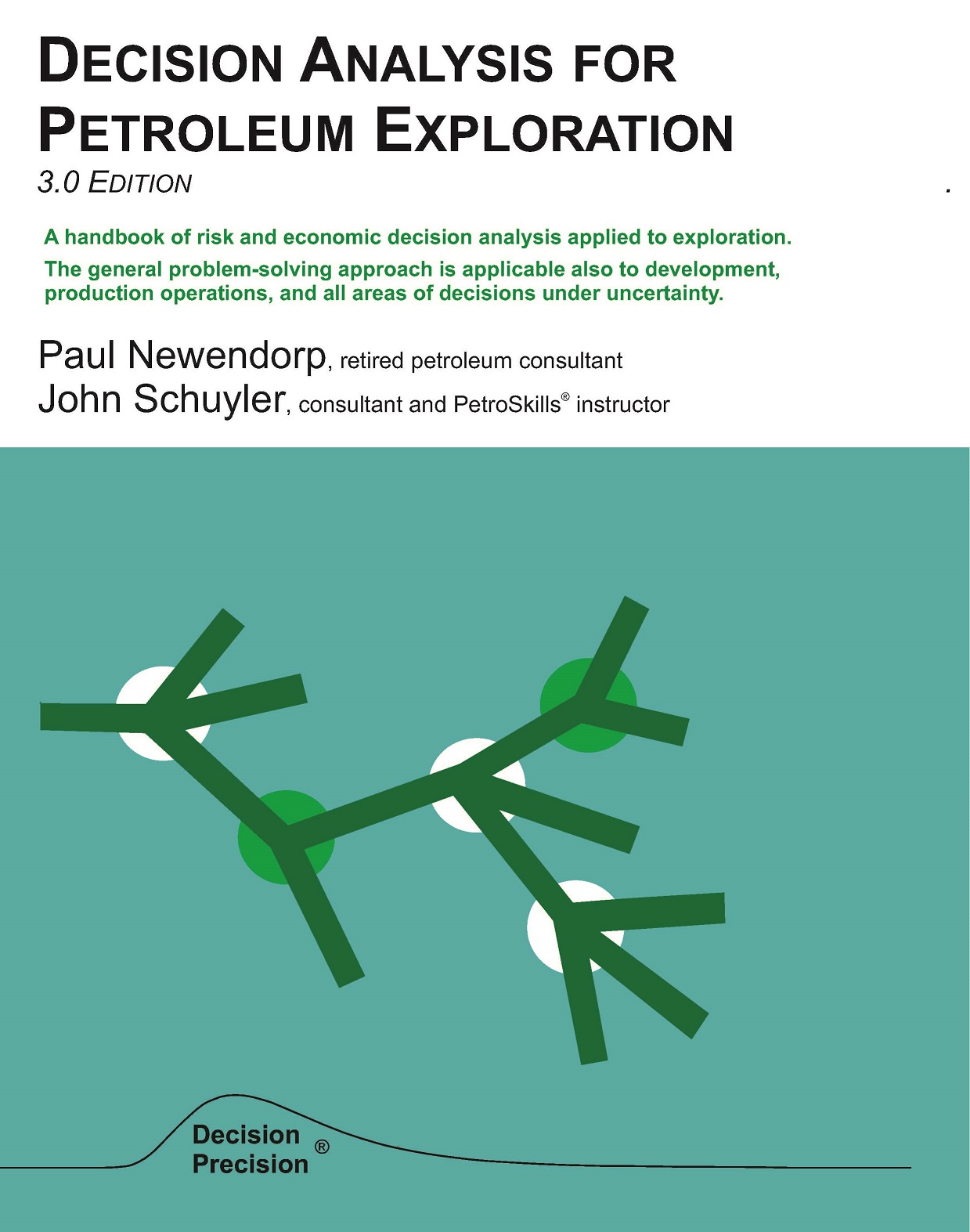

BOOKS ABOUT PLANNING AND EVALUATION TECHNOLOGY
Decision Analysis for Petroleum Exploration, 3.0 Edition
The 3.0 Edition is now available and
is a major upgrade.
Now designed as handbook for quick topic access.
List price US$79.95. ISBN
978-0-9664401-4-0
by Paul Newendorp and John
Schuyler
3.0(.5) Edition, Dec. 2014, ~570 pages, softcover, US$79.95 List
Planning Press, Aurora, Colorado USA
ISBN 0-9664401-4-5 EIN 978-0-9664401-4-0
 This
is a major rework of Paul Newendorp's 1975 best-seller, which became the
standard reference in the field. This book is now structured as a handbook
of important concepts useful in risk and economic decision analysis. As the
title suggests, well over half the examples apply to petroleum exploration
investment decisions.
This
is a major rework of Paul Newendorp's 1975 best-seller, which became the
standard reference in the field. This book is now structured as a handbook
of important concepts useful in risk and economic decision analysis. As the
title suggests, well over half the examples apply to petroleum exploration
investment decisions.
Topics in the book represent a composite of evaluation practices and
problem-solving approaches now commonly used in oil & gas and other
capital-intensive industries. Several important and practical techniques
were first published in the first edition.
Decision analysis methods apply to any type of
decision. The emphasis here is on quantitative methods useful in capital
investment decisions and decisions to acquire additional information. This
will be of special interest to anyone involved in the evaluation of property
acquisitions, geophysical surveys, prospect drilling, and field development
decisions. This book is intended for petroleum geologists, engineers,
geophysicists, evaluation and planning analysts, and managers. No special
background in mathematics or statistics is required. We do presume a general
familiarity with management, economics, and knowledge of the industry.
As a handbook we are
focusing on what is most important and practical. Major topic area include
the decision analysis process, key concepts in probability and statistics
(including Bayes' rule and easy equivalents), decision policy (including
risk policy expressed as a utility function), popular economic metrics and
concepts, project and enterprise modeling, decision tree analysis, Monte
Carlo simulation, and various special topics. Value of information problems
receive special attention.
The expected value (EV) concept is central throughout.
Most often we assume a decision policy that maximizes EV. Most of the
discussion presumes the business context and measuring outcome as net
present value (NPV). We also describe approaches for multi-criteria decision
making including HSE.
Expected monetary value (EMV = EV NPV) is the principal decision criterion
used in most examples. The EV calculation incorporates judgments about risks
and uncertainties expressed as probabilities and probability distributions.
EV is the cornerstone of formal, quantitative analysis for decisions under
uncertainty. The key calculation methods are decision trees and Monte Carlo
simulation. Small decision trees can be solved with a hand calculator, while
larger trees and Monte Carlo simulation usually require a computer. Software
supporting these methods is now widely available as Microsoft® Excel
spreadsheet add-ins and for other platforms.
The material is organized into seven sections:
Decision Analysis Process, Probability and Statistics, Decision Policy,
Economic Matters, Modeling, Decision Tree Analysis, and Monte Carlo
Simulation. Throughout, real-world exploration examples are presented to
illustrate the risk and decision analysis methods.
This revised 3.0 edition features
a larger page format, an updated and expanded bibliography, and an extensive
glossary. We also offer additional material online, including extended
discussions, software resources, and example Excel spreadsheets. This
version has a larger, 8.5x11" soft-cover format.
Available from Amazon.com (link to the book)
|
Prior
course participants can order this from Amazon with a code for 25% off, plus postage
and handling. Write to
john@maxvalue.com for the discount code. |
|
|
|
Corrections and Extensions Errata in the present and earlier editions |
Sections
- Decision Analysis Process (pp. 1-52)
- Probability and Statistics (53-240)
- Decision Policy (241-284)
- Economic Matters (285-324)
- Modeling (325-368)
- Decision Tree Analysis (369-420)
- Monte Carlo Simulation (421-448)
- Authors, Software Appendix, Bibliography, Glossary and Index (449-525)
Paul Newendorp (first author)
Dr. Paul Newendorp began his career in 1959 as a petroleum engineer for Pan American Petroleum Corporation (now Amoco Production Company). During two later educational leaves of absence he completed his MS and Doctorate degrees in Petroleum Engineering from the University of Oklahoma. In 1968 he developed a two-week short course on petroleum exploration economics and risk analysis. The course was based, in part, on his Doctoral research on decision theory and earlier industry work experience.
For the next 21 years Paul traveled throughout the world teaching his short course. Entitled "Decision Analysis for Petroleum Exploration," the course introduced many new concepts into the lexicon and accepted practice for analyzing drilling prospects. Included was his pioneering work on the use of Monte Carlo simulation for the quantification of exploration risks and uncertainties. His course, research, and numerous publications also brought into focus how established decision theory methods such as the expected value concept, decision tree analysis, and utility theory can be used to advantage in evaluating drilling prospects. This book was written in 1975 for use as a text for his 2-week course with the same title.
During his career Paul was an active member of the Society of Petroleum Engineers. He served in various leadership roles and received numerous awards, including the SPE Section Service Award. In 1987-1988 he was appointed an SPE Distinguished Lecturer. He was also an associate member of the American Association of Petroleum Geologists.
Dr. Newendorp retired in 1989 and now lives in Colorado. His retirement activities include work as a volunteer for the U.S. Forest Service.
Timothy Nieman
Has also contributed to our course materials and, thus, portions of this book. Tim will be listed as co-author on the next edition.
John Schuyler (revisions author)
Upon nearing retirement in 1988, Paul Newendorp encouraged John Schuyler, one of his former students and a longtime colleague, to design a successor course. John developed what has become his primary course, "Petroleum Risks and Decision Analysis," and variants which have been presented more than 200 times in 34 countries since 1990. This one-week course includes and extends the concepts in Dr. Newendorp's book.
John holds BS and MS degrees in Mineral-Engineering Physics from Colorado School of Mines and an MBA from University of Colorado at Boulder. He was formerly VP and Petroleum Evaluation Engineer with Security Pacific Bank, Planning and Evaluation Analyst and Manager-Business Systems for Cities Service Company, and a Senior Management Consultant with a national accounting firm. He is a CAM, CCP, CMA, CMC, DRMP, PE (CO) and PMP. He is a member of AACE, IMA, IMC, INFORMS, PMI, RMAG, SPE and SPEE. Project Management Institute published, Risk and Decision Analysis in Projects (1997 and 2001 editions).
John's petroleum industry training is sponsored by PetroSkills, LLC., the world leader in petroleum training. He is the course director. He and Tim Nieman teach the DA courses:
- Petroleum Risks and Decision Analysis he now regularly presents two additional courses through OGCI:
- Advanced Decision Analysis with
Portfolio and Project Modeling
(a sequel workshop with hands-on use of personal computer software
Course schedules and descriptions see Decision Precision and PetroSkills (bio + course links)
Available from Amazon.com
Planning Press™
15492 East Chenango Avenue
Aurora, Colorado 80015-1703 USA
Phone: (303) 693-0067
(UTC/GMT -6 or -7, depending upon time of year)
books@maxvalue.com
Also available: Risk and Decision Analysis in Projects 3.1 Edition (2018) by John Schuyler
Work on a 3.1 edition is planned for this year. Anticipated availability late 2020.
Please use your browser's Back button to return.